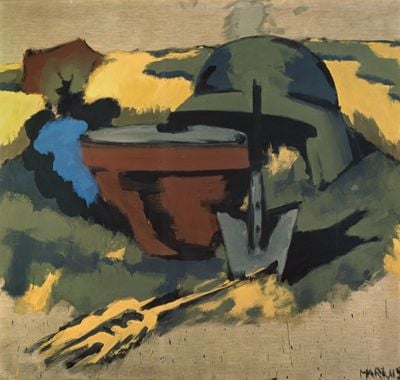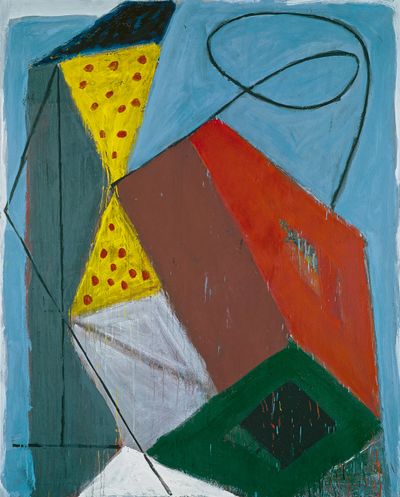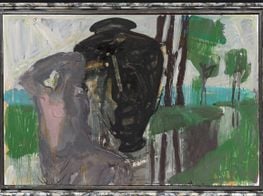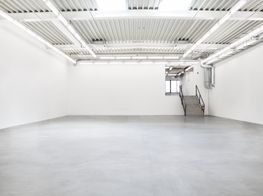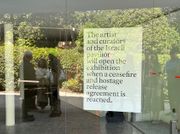Markus Lüpertz: a bull in the china shop of cultural history

Markus Lüpertz, Arkadien—Der hohe Berg (Arcadia—The High Mountain) (2013). Mixed media on canvas. 51 1/4 x 63 3/4 in. Private collection. © 2017 Artists Rights Society (ARS), New York / VG Bild-Kunst, Bonn.
This is quite an event: twin exhibitions of paintings by Markus Lüpertz, one of the giants of late 20th-century European art, taking place at The Phillips Collection and Hirshhorn Museum and Sculpture Garden. This first collaboration between these two jewels in Washington, D.C.'s cultural crown, Markus Lüpertz (at The Phillips until 3 September) and Markus Lüpertz: Threads of History (at the Hirshhorn until 10 September) has resulted in Lüpertz' first proper museum retrospective in the United States. If that were not enough, Michael Werner, Lüpertz' dealer and tireless champion since 1968, is showing Markus Lüpertz: New Paintings at his New York gallery until 7 July 2017.
The good news is that the 76-year-old Lüpertz emerges from all this exposure as precisely what some of us had always imagined him: an artist of the first rank who has made a career out of audacity, and a style out of inconsistency.
Though these shows entirely omit Lüpertz's sculpture, and thus simplify his oeuvre somewhat, his art remains at once thrilling and bewildering. He seems to reject his sources precisely as he draws upon them, to thumb his nose at the very cultural precedents he reveres, and to pay no attention whatsoever to distinctions between different sorts of painting.
This perversity marks Lüpertz's career from its very outset, with his adoption of the word dithyrambisch (dithyrambic) as a watchword for much of his art practice, and which he appended to many of his titles between 1962 and 1976. (There are more than 30 examples in these exhibitions.) A dithyramb in classical mythology is a wild choral hymn dedicated to Dionysus, and Lüpertz borrows the term from Nietzsche.
But while he maintains the word's classical and philosophical echoes he uses it to identify his own highly egocentric art philosophy and an undisciplined painting style which commentators quickly dubbed neo-expressionist and which Lüpertz himself maintained was neither representational nor abstract.
Then there was the emergence of his Deutsches Motive (German Motifs) paintings in 1970. In a still divided, traumatised, and widely guilt-ridden Germany just a quarter-century after the end of the Second World War, Lüpertz began making paintings of Wehrmacht helmets and uniforms and other representations of the country's National Socialist past. There are more than a dozen of these paintings in the two shows, including the remarkable trio of eight-foot-high Zyclop (Cyclops) paintings from 1973 at the Hirshhorn, in which messily painted dark green uniforms mutate into monsters.
Once infamous, this strand in Lüpertz's art is now seen as part of an outdated current in post-war German history, which allowed a younger generation of German people to find their own identity not saddled by their parents' guilt and as part of a contemporary Europe. For what it's worth, this was imagery Lüpertz stuck with: there are Untitled helmet paintings in The Phillips exhibition from as late as 2009.
It was an inspired decision to stage these two exhibitions side by side (or actually about an hour's walk apart). In terms of total size, they could easily have been squeezed into either museum, but then we would have been deprived of the sense of dislocation which comes from moving between a career-wide retrospective and a more focused show of Lüpertz's 1960s and 1970s paintings, and thus a genuinely unnerving demonstration of how bizarre has been the trajectory of his career.
At The Phillips Collection, which is still housed in an expanded form of its founder's Georgian Revival mansion out in Washington's leafy Dupont Circle neighbourhood, we are presented with a survey of 50 years of Lüpertz's painting.
So varied are the works the survey includes that this would have been unsettling enough had Lüpertz not shown up days before the show's opening and decided to completely disorganise curator Dorothy Kosinski's carefully planned chronological hang so that pieces could relate to one another back and forth between various points in his career.
Thus an almost entirely abstract painting like Stil (Style) (1977) hangs adjacent to one of Lüpertz's reworkings of a classical subject, Satyr + Nymphe II (Satyr + Nymph II) (2014); and one of his many portrayals of the human back, Nacht (Night) (2013) hangs next to a painterly treatment of building materials, Holzschindeln—dithyrambisch (Wood Shingles—Dithyrambic) (1966). It is almost as though we are looking at a group show of several different artists.
Then over in Gordon Bunshaft's iconic circular Hirshhorn building we meet another artist again, an artist employing a higher-keyed palette than anything in The Phillips.
There are two of the Donald Duck paintings that Lüpertz made in 1963. Combining bright colour and splatter-and-drip paint handling, they are bastard offspring of American Abstract Expressionism and Pop, but finish up looking like neither. There is a room filled with Lüpertz's brightly-coloured paintings of family vacation tents.
There is his remarkable 40-foot-long Westwall (1968), a hard-edge and somewhat abstracted representation of the tank traps that formed part of the so-called Siegfried Line, a 400-mile-long defensive structure built along the western border of Germany at the beginning of the Second World War.
In an antechamber of the Hirshhorn show there is a timeline on one wall, which attempts to make sense of Lüpertz and his work. Thus the events of his career are sandwiched between world events (like Kennedy's 1963 'Ich bin ein Berliner' speech, or the 1969 moon landing) and art historical ones (such as Christo and Jeanne-Claude wrapping the Bern Kunsthalle in 1968, or Robert Smithson building the Spiral Jetty in 1970).
It is a brave effort, but it is doomed to failure, for Markus Lüpertz is not an artist whose work can be explained away by its context. He is a bull in the china shop of cultural history who uses subject matter and styles as they suit him. This alacrity lies at the core of his art, and it is what makes him so powerful an artist. It is also what makes these current exhibitions of his work so rewarding. —[O]

